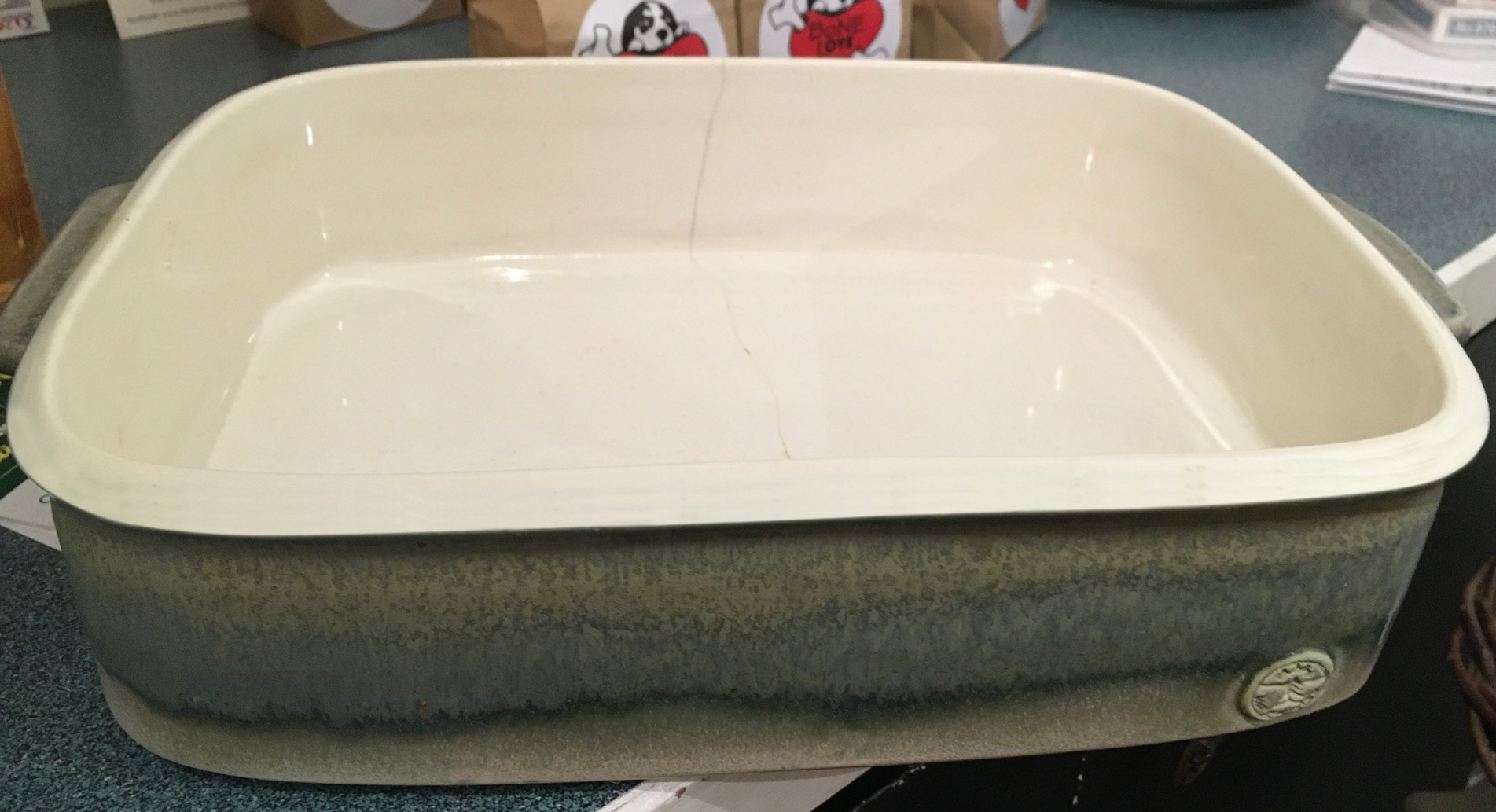| Monthly Tech-Tip | No tracking! No ads! | |
Dunting
Dunting generally refers to firing cracks that occur in ceramic ware as it is cooled in the kiln. The reason is generally uneven cross section or too rapid cooling.
Key phrases linking here: dunting - Learn more
Details
Dunting is cracking associated with too rapid a cool-down of the kiln. Dunting often exhibits itself as simple hairline cracks, but ware can fracture into pieces.
More specifically, a body recipe may create a ceramic that is unable to withstand reasonable cooling shock (e.g. have too much silica and too little feldspar to produce a vitreous body with reasonable mullite development). Or ware may have a poorly fitting glaze that creates stresses and places for cracks to propagate. Ware of uneven cross section or larger pieces cannot withstand quick cooling nearly as well. Quartz and cristobalite inversions are the most sensitive periods of cooling, especially for ware of uneven cross section or where the kiln is not heating ware evenly. A worst case scenario is a large flat plate made from a high silica non-vitreous porcelain, covered with a crazing glaze on the outside and excessively compressed one on the inside, having a thin lip and a thick base, fit tightly into an electric kiln with the lip close to the elements and cooled quickly through quartz inversion.
Related Information
A dunting crack

This picture has its own page with more detail, click here to see it.
Example of a dunting crack in a flat deep cone 6 porcelain bowl. The bowl has a wide bottom that heat-sinks to the shelf, so during firing there is a temperature gradient between the walls and the base. That difference in temperature translates to stress because it means that different parts of the piece are experiencing different thermal contractions as it cools in the kiln.
Can a glaze crack a plate? Yes.

This picture has its own page with more detail, click here to see it.
This is a thin slip-cast plate made from a high-silica (therefore high thermal expansion) clay and a thick layer of low thermal expansion glaze. During the cooling in the kiln the clay shrinks and the glaze shrinks less. This puts the latter under compression, and the body under tension. A ceramic does not do well under tension. A week after firing the piece spontaneously cracked to relieve the tension.
An example of dunting on a low, flat casserole shape

This picture has its own page with more detail, click here to see it.
The firing crack from the rim down has released the stresses produced by uneven thermal contraction during cool-down in the kiln. Any factor that contributes to a temperature gradient within a piece will contribute to the likelihood of dunting. Cooling too quickly through quartz inversion, for example, can cause this in almost any piece. Pieces that are thick and heavy, or have uneven cross section (with thick foot and thin walls, for example) will certainly suffer gradients, even in slow cooling. A wide, flat bottom (that is heat-sunk by the a heavy shelf) will also increase the temperature gradient between the outer walls and the inner foot. If that wide piece has vertical walls that get direct radiant heat, especially if one part is more exposed to the elements, it will start a gradient during the up-ramp in the firing. And, on the down-ramp, it will "come back to bite you" with a crack.
An unevenly cooled tile has cracked

This picture has its own page with more detail, click here to see it.
Example of a severely dunted cone 6 stoneware tile. This problem was deliberately created by stacking several tiles on top of this one. This set up a temperature gradient across it so that different parts passed through quartz inversion at different times.
Low fire ware cracking during firing. Why?

This picture has its own page with more detail, click here to see it.
Most low-fire bodies contain talc. It is added for the express purpose of increasing thermal expansion. The natural quartz particles present do the same. These are good for glaze fit but bad for ware like this. There are also sudden volume changes associated with cristobalite, but it forms (from quartz) at stoneware temperatures so should not be a concern in terra cotta or a white low fire body. You could fiddle with the clay recipe or change bodies, but better to change the firing schedule. The quartz in stonewares goes through a sudden volume change between 950-1150F on the way down. Quartz particles in low fire bodies will do the same. A simple fix is to slow down the entire cooling cycle like this potter did. Or, learn to program your kiln to approach this range more slowly, then ease down through it. No electronic controller? Learn a switch-setting-schedule to approximate this down-ramp (buy a pyrometer if needed).
Links
| Materials |
Silica Sand
|
| Glossary |
Thermal shock
When sudden changes in temperature cause dimensional changes ceramics often fail because of their brittle nature. Yet some ceramics are highly resistant. |
| Glossary |
Quartz Inversion
In ceramics, this refers to the sudden volume change in crystalline quartz particles experience as they pass up and down a temperature window centering on 573C. |
| By Tony Hansen Follow me on        |  |
Got a Question?
Buy me a coffee and we can talk

https://digitalfire.com, All Rights Reserved
Privacy Policy
